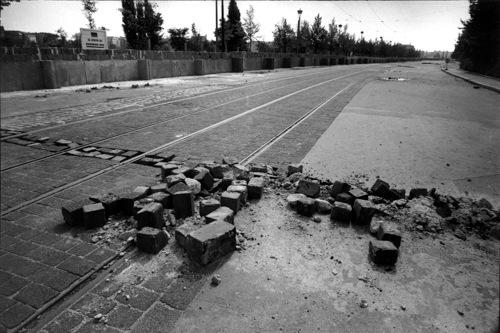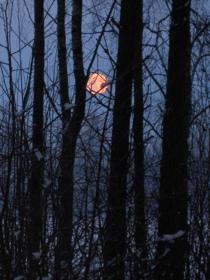
I’m not sure if I was in Lithuania one recent evening—and it wasn’t the sweet Russian champagne. My wandering started in the village of Krasnogruda in northeastern Poland, home to the poet Czesław Miłosz’s mother, and only about a mile from the Lithuanian border. As the full moon rose and the pines turned blue under their weight of snow, I might have crossed into Lithuania. Or perhaps not. Not so very long ago this invisible border was the western frontier of the Soviet Union, perhaps the most heavily guarded in the world. When I first came to eastern Europe in 1990, it was triply patrolled: by a Poland just emerging from Communism, by a Lithuania not quite yet independent, and by a Soviet Union that still in some measure existed. Today Poland and Lithuania are both democracies within the European Union, and their shared border, unmarked for almost all of its length, is all but invisible.
The revolutions of 1989, the end of the Soviet Union in 1991, and the enlargements of the European Union to the east in 2004 and 2007 have extended the zone of free movement and economic exchange in Europe, and brought new liberties to ten formerly communist countries, of which three—including Lithuania—were former republics of the Soviet Union itself. The sense of borderlessness I experienced between Poland and Lithuania is quietly repeated hundreds of thousands or millions of times every day by EU citizens and tourists; in much of Europe, the old borders have become a distant memory.
Yet, while attending several celebratory conferences over the last few months about the revolutions of 1989, I found myself thinking about the new walls that have risen within and around Europe. The same Schengen agreements that create a zone of free internal movement for all but a few EU members require the construction and defense of a single external European frontier. This is as it must be; but with the result that someone from beyond the zone, from Belarus or from Turkey, may find herself refused entry. The difference between not needing a passport at all and needing a special visa is considerable, and creates a distance that can be psychologically and politically damaging.
Europe itself seems much further from the United States than it did twenty years ago. In western Europe, the election of Obama has undone some of the feeling of estrangement that resulted from the American decision to invade Iraq; while in some east European countries, such as Poland, Obama sometimes takes the blame for the weakened American position in world affairs. In the meantime European and American society have become increasingly incomprehensible to one another. Standards of living in several west and central European countries are now much better than in America. I did not expect twenty years ago that poor Poland could become so quickly comparable to the United States in its infant mortality rates and life expectancy. Its downtowns feel safer and its public transportation is better. Although Poles and other east Europeans are more likely than West Europeans to repeat the rhetoric of economic libertarianism, they accept the fundamentals of the welfare state that in America are now so contested. It is no easier to explain American debates over health care reform in Warsaw than in Vienna.

Yet all is far from well within Europe. In much of central and eastern Europe, nationalist populism—whether in Russia, Poland, Hungary, or Austria—is more resonant than twenty years ago. Throughout the continent, pedagogical systems have remained national, or, in such cases as Russia and Ukraine, become so. Young people in almost every European school system learn versions of history more appropriate for the nineteenth century than the twenty-first. The very progress of political integration in Europe has created, ironically, new nationalist temptations for politicians such as Václav Klaus, president of the Czech Republic, or Robert Fico, prime minister of Slovakia.
In these and other new member states of the European Union, political leaders once restrained by their countries’ efforts to join the European Union now feel free to do as they like. The weakness of the national state in many places inclines politicians to use what power they have to revive national anxieties and symbols. Hungary and Slovakia managed last year to engage in a highly emotional dispute over border crossings, even though their common border is no longer even guarded. Poland and Ukraine patrol their national history with powerful memory institutes, just at a time when the opening of archives should allow these countries’ pasts to be considered within a broader European setting. Overlaying it all is the unfortunate international culture of “memory,” which under a deceptive sheen of tolerance is often nothing more than the resuscitation of narcissistic myths of national exceptionalism and martyrdom.
That evening in Krasnogruda, my cell phone thought I was in Lithuania. The radio waves also created a new kind of barrier. Over these past few months, when I visited exhibitions of photographs taken of the revolutionaries of 1989 in Warsaw or Prague or Timisoara or Leipzig, I could not help, from the perspective of today, but see them this way: as people not concerned that a sudden vibration in their pockets might call them to order. There was no email waiting on a computer that might be more important than the sights before their eyes. Life was not elsewhere. Email and wireless certainly aided oppositionists in Belgrade in 2000, Kiev in 2004, and Teheran in 2009. The point is not that technology must be conservative, rather just that changes in technology can mark, rather quickly, a boundary between one epoch and the next. It is no doubt romantic to say so, but the revolutions of 1989 had a human character that may not be possible to replicate today.
Advertisement


